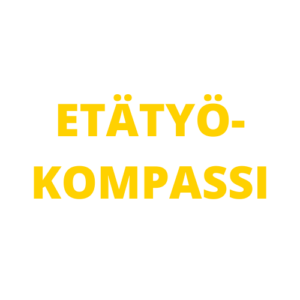
Table of contents
Leading remote work – preliminary results of qualitative research data
Remote work in the digital workplace – transition and change in organizational culture
E-leadership and the new role of the immediate supervisor
Self-leadership and harnessing individual strengths
Work-life balance in remote working
Leading remote work - preliminary results of qualitative research data
New way of working
The LEADIS research team conducted a qualitative interview study in October-December 2020. As a part of the study we collected experiences of employees and managers from remote working and remote leadership.
The study included three main themes: e-leadership, self-leadership and work-life balance in remote working. Additionally, we explored the experiences from the transition to remote working due to the COVID-19 pandemic, and the impact that remote working has had on the organizational culture and way of working.

Suggestions and recommendations for leading remote work successfully
The purpose of this study was to identify key factors to support well-being and successful leadership in remote working, and to provide practical recommendations for remote workers and employers. The report describes practical experiences and reflections of the interviewed remote workers. The research material will be utilized in scientific publications, doctoral dissertations and master’s theses.
We interviewed 89 remote workers, of which one third represented supervisors from ABB, Fennia, Accountor, Telia Company, Visma and Wärtsilä. The interviews were carried out by the LEADIS research group and additionally two students, Tiia Nikander and Johannes Karhu, who are working on their master’s theses.
Thank you for taking the time to participate to the interviews!
Remote work in the digital workplace - transition and change in organizational culture
People are largely satisfied with remote working
The experiences of remote work are positive, and people are satisfied with the work arrangements.
Remote work has brought more time into everyday life that has been used for recovery and rest.
Working remotely increases autonomy and opportunities to reconcile work and household chores in a way that suits oneself.
The home environment has enhanced concentration and efficiency.

The transition to remote working has been smooth
The transition to remote working has been smooth and information from the employer about the transition to remote work was considered sufficient. The immediate supervisor has been an important source of information. Organizations were familiar with digital work. Most of the work can be succesfully done also remotely, with only a few individual tasks requiring a visit to the office.
Remote work is successfull with the help of diverse applications in the digital workplace. The programs and applications used for work are the same as in the office environment. However, the use of enterprise collaboration systems, such as Microsoft Teams, has expanded. Some variation in network connection quality was experienced challenging. Some employees have a network connection provided by the employer, although many have a privately acquired network connection.
The remote work environment is most frequently the person’s own home. Some have also utilised public remote workspaces as an alternative. Most interviewees have a separate home office or other quiet space for working. As a rule, the employers have provided a workstation and office chair for home use. However, the ergonomics still needs improvement and support from the employer. For instance, an electric standing desk could improve the ergonomics in the home office environment.
Remote work has changed the organizational culture - trust is the key to business success
The remote work culture and attitudes towards remote work have improved in comparison with the time before the exceptional circumstances and recommendations for remote work caused by the COVID-19 pandemic. Remote work is now widely accepted – in several companies it was previously limited and regulated. Trust is seen a as pivotal element in constructing a remote work culture. As the new way of work is more familiar, people believe and hope that remote work will continue as one of the established forms of work. However, mentoring new employees in the context of remote work was experienced challenging. For instance, transfer of tacit knowledge, creation of social relationships and adoption of organizational culture were mentioned as challenges in the remote work context.
With the transition to remote work, there has been a need to create new norms and working procedures, for example in terms of meeting culture and interaction practices. Virtual meetings are often perceived as more official and effective than meeting in person. On the other hand, some employees felt that virtual meetings were mounting up and often there was no break between them. Thus, the quantitative increase of virtual meetings might cause stress.
However, new types of meetings have been introduced in remote working, such as walk-and-talk meetings, regular virtual coffees and daily news and greetings. Good practices in involving all employees have emerged in the meetings. For example, those who are less likely to express opinions can participate in remote meetings through the systematic sharing of turns to speak. Common principles and practices have been created for accessibility during working hours, internal contacts and response times.
Best practices for working remotely (from home):
Tracking of results, not working hours
Established principles for accessibility and meeting culture
Not too many meetings per day (the importance of breaks)
Supporting social interaction and unofficial communication in remote work context
Integrated tools and rules on the use of communication channels (prioritization of important and urgent information)
A new context for leadership
Working remotely created a new context for leadership: virtual interaction and communication as well as physical distance between the parties are being emphasized. The employees’ experiences of e-leadership were very positive, there were hardly any who felt that leadership had moved toward a negative direction.
Greatest challenge perceived by the immediate supervisors was how to create an overall picture of the situation of the team members and how to catch up on how they were really doing. How to really reach someone and ensure genuine encounter and communication? Also the lack of body language and gestures in communication were mentioned as important factors in this context.
Change in interaction practices
The importance of interaction practices has been emphasized. The question seems to be ”How and when to contact?” – in virtual channels people are constantly reachable. Thus, the challenge is to recognize when the other one is genuinely available.
All in all, virtual interaction transforms the communication as more straight forward. Virtual interaction was found to be more functional in some situations compared to a face-to-face interaction situation. The topics are often more official and subject-focused. E-leaders used versatile communication channels that were appropriate to each situation.
Some personal matters were even easier to deal with through private and peaceful virtual connections. In general, the overall perception was that almost anything could be handled virtually.
According to the results, it was easier to maintain regularity in communication through virtual channels. Some people Felt that their leader-subordinate relationship had improved during the remote work period due to more frequent and straightforward interaction. On the other hand, lack of communication and interaction might emphasize the distance between the parties.
Increased autonomy and self-management skills
In general, the transition to remote work has increased the employee’s autonomy and responsibility for leading their own work, and this changes the role of the immediate supervisor. It is pivotal to support the team members’ independent work and self-management skills.
Open and transparent support as well as feedback and motivation increase the internal functioning of the team and a sense of equality between team members. The e-leader should consider everyone’s personal situation and implement decisions and policies accordingly. It it also important to keep up the team spirit, and to defend the team, for example, in matters related to the workload. The employyes should feel that the immediate supervisor has time for me, even in a remote work context.
The immediate supervisor should thus emphasize personal interaction and communication, as well enable situations when employyes have a possibility to share one’s private matters. Also genuinely knowing one another and having an interest towards each other is important. Giving feedback is also important – although quality matters more than quantity.
The role of the immediate supervisor - diverse perceptions
A significant finding was that the role of the immediate supervisor in the remote work context differed somewhat in the perceptions of the supervisors themselves and their team members. Supervisors saw their role as a coaching and supporting leader. The employees felt that it was important that the supervisor was reliable and easily accessible background force and enabler.
The context of remote work poses new skill requirements for the immediate supervisor. Hence, the immediate supervisor should handle virtual communication skills, planning of own actions and interaction (when, how, and how often to be in contact) and understand the importance of emotional intelligence and discretion.
Leading employees through their strengths could, to a greater extend, be made use of in remote leadership, as employees feel empowered and inspired when being able to harness personal strengths.


Interaction:
- Enough time for one-to-one discussions between the employee and the supervisor
- Sufficient contact with employees (although excessive interference in employee’s work should be avoided)
- Regular virtual meetings – higher in frequency but shorter in lenght
- Informal events (virtual coffees, etc.) maintain social well-being of team members
Support to employees:
- Supporting employees in self-evaluation, and ensure that work load, work complexity and personal skills/resources are in balance
- Consideration of the employee’s life situation and family demands is an important part of remote work arrangement
- Instead of monitoring time and tasks, leaders can focus on building trust and encourage employees for greater self-direction
The qualities of a good e-leader:
- They are reachable
- They are interested in organizing one-on-one time and possibilities for interaction
- They trust in their team members and to their ability to do their jobs independently
- They give feedback on work well done, quality matters more than quantity
- They communicate things openly and fairly
Self-leadership and harnessing individual strengths
Self-leadership refers to the process by which a person influences and leads his or her own actions through strategies related to behavior and cognition (e.g., using one’s own strengths, tuning the work, fostering positive thinking and setting goals).
Due to the special features of remote work itself and remote work context, self-leadership is needed in these circumstances. The individual strengths and their utilization at work are related to self-management skills.
The importance of self-leadership is emphasized in remote work
Remote employees experience increased autonomy. It also means that the responsibility for organizing of one’s own work is largely left to the individual. Therefore, self-leadership skills become valuable in remote work. Self-leadership is needed for planning, scheduling and monitor one’s own work.
Getting started in the beginning of the day or workshift has been found even easier at home. Employees get more work done within same working hours when working at home – although keeping sufficient breaks is challenging for many.

New ways of self-leadership have emerged
Setting daily goals and overall scheduling of activities is rather important. For example, immediate supervisors have to do lists and checklists as reminders for keeping regular contact with team members.
Qualities of good self-leadership skills identified by the interviewees:
Proactivity
Taking responsibility
Planning skills
The ability to prioritize
The willingness to take on challenges
Good self-knowledge
Awareness of one’s own needs
Willingness to learn more

Best practices for self-leadership:
Effective prioritization of work tasks
Daily task management
Setting daily goals
Virtual to-do lists and calendar management
Markingof dailybreaksin calendar
Assessment of own workload, work ability and resources
Utilization of task planning & management tools (e.g. Kanban Board, Trello and Pomodoro Technique)
Harnessing one's own strengths is an empowering experience
Strengths that remote workers had identified as supportive for good self-leadership were such as self-initiative, proactivity, persistence, resilience, problem-solving skills, and readiness for change.
The experience of being able to utilize one’s own strengths at work was described as very empowering and inspiring.
Organizations did not have official processes for leading with strengths, but employee strengths had been identified and considered in goal setting and responsibility delegation.
Interviewees' experiences of using strengths:
”Strong feeling of being able to do big stuff.”
”Encourages.”
”World Champion feeling.”
”Positive feelings.”
”Strong sense of success.”
”Effective and good feeling.”
Remote workers feel inspired by positive experiences and feedback
Remote workers experienced feelings of enthusiasm when they felt that their work was considered important and valuable for the company and the customers. Enthusiasm was also related to a feeling of being successful and productive at work. Enthusiasm was often linked to a feeling of having enough challenge, and could mean new opportunities, learning new skills and career advancement. Also feedback plays an important role.
Personal feedback was experience specifically inspiring and encouraging in remote work. Feedback that was directed to teams was also considered as essential alongside with personal feedback, but it was experienced as more official.
Setbacks and conflicts create greater emotional strain when employees are remote and alone
Remote working as such has not increased amount of conflicts and concerns among employees – issues faced in remote work were similar to those faced in office. Setbacks and conflicts, however, were experienced more burdensome in remote work, while there was no access to immediate support. For example, there was said to be a higher barrier to contact colleagues and interrupt the work of others. Support from immediate supervisor was considered crucial when facing demands and difficult situations.

Common goals support self-direction in remote work
The importance of goals differed between remote workers and teams. Some considered goals as ever more critical given the independent nature of remote work. Others however felt significantly less connection between goals and their daily work.
There were various possibilities to influence own goal setting: less possibility to influence numeric goals, yet good possibilities to contribute to the results with own work input. Still there was full possibility to influence development goals, although not all employees had separate goals for development.
Many organizations had implemented tools for goal managament. This increased transparency and enhanced employee self-direction. Recognition and celebration of achievements were experienced particularly important in remote work and created positive spirit.
Consider in remote work:
Awareness of common goals
Ability to influence own goals
Ability to follow progress in real time
Celebration of achieved goals
How to manage with emotional strain caused by setbacks:
Taking a short break
Going outdoors
Active problem solving
Seeing obstacles as a way of learning
Peer support
Supervisor support
How to feel enthusiasm in remote work:
Positive feedback from colleagues and customers
Getting things done
Reaching goals
Seeing the results of one’s work
Noticing the value of one’s work
Experience of being useful and helpful
Work-life balance in remote working
Work-life balance means an individual’s experience of having the different areas of life in good balance. Work includes all work-related activities, whereas the life outside of work consists of home related duties and leisure activities, as well as rest and recovery.
Psychological detachment from work is an important means of recovery. It means physical and mental disengagement from work-related demands and stress, allowing sufficient recovery.

No need to think work during leisure
Remote workers describe good work-life balance as ability to control one’s own time and resources – one should have a feeling of having enough spare time and there is no need to think about work during leisure. The balance is influenced by work related expectations and available resource and support. It is important to have a feeling that one can complete work within the working hours. Expectations from supervisors and colleagues (e.g. availability outside of working hours) and supervisor support in workload and resource management is also crucial. Trust from the employer is emphasized when enabling flexible working hours.
Remote working has helped the reconciliation of work and home demands
Decreased time spent on commuting and increased work productivity have freed more time for rest and recovery. This has improved possibilities to adjust working hours with house chores and family demands. Time spent with family and near ones has increased.
All in all, remote work has a positive effect on overall life satisfaction and happiness – sufficient amount of work, trust and flexibility are the basis for a good work-life balance.
“You think that you’ll just quickly take care one work issue, but suddenly it’s taken an hour… From your weekend.”
“I open my laptop as I wake up.”
“I simply get more work done at home, without distractions.”
“I eat and drink my coffee in front my PC. Most days that becomes my breakfast and lunch.”
“I hardly move from my chair at all…”
“Setbacks feel much worse than they actually are when alone.”
Remote workers experience less distractions at home than at office - work becomes increasingly intensive
Home as a work environment increases focus and efficiency. There are less interruptions and noise as well as less hurry and sense of urgency caused by transitions from one place to another.
At the same time the home environment increases the work intensity: working hours increase insidiousl, breaks are often skipped, lunch hours become shorter, physical activity (standind, walking) during work days decreases, dealing with challenges and conflicts is more burdering remote and alone as well as there is longer lead time to get access to support.
Promoting work-life balance:
Flexible working hours
Autonomy in planning and execution of work
Trust from the employer
Employer that is aware and takes employee’s life situation in account
Preventing work-life balance:
Uncontrolled workload
Emotional workload
Leisure time continuously becomes interrupted by work
Insufficient support with workload management


Detachment from work in the home environment can be promoted with deliberate actions and routines
Physical and psychological detachment from work was initially experienced as challenging but as remote working has continued new routines have been established to promote it. Some of the routines include for example: work day scheduling and a specified time for beginning and ending, repetitive routine to end a working day, and turning off work devices (laptop, mobile phone etc.) at the end of the work shift.
Detachment from work can be supported with prevention of work related stress and workload. This includes making sure that workload is in balance and planned work can be done within agreed working hours. Unfinished work should not cause feeling of guilt that spills on one’s spare time. It is important that emotionally stressful issues are effectively resolved, preventing them to burden employees during off-job time.
The employer shoud send a clear message that one’s work is valued and secured, and there is no need for overstretch. Meaningful and captivating leisure activities also help to separate work and leisure.
Best detachment practices:
Physical exercise and outdoor activity
Physically leaving the work environment when work is finished (e.g. going outdoors)
Shifting focus to non-work related activities
Conscious decision to end work and stop thinking about work
Creating a list of urgent matters and unfinished tasks to be attended later and consciously removing them out of mind for now
Scheduled leisure and family activities after work


